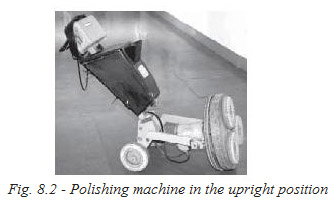There are two types of floors - rough and smooth. Rough materials such as cement do not need polishing. Smooth materials such as cuddapah, mosaic, marble and tiles need to be polished at least once a year. Although floors are cleaned and swabbed several times a day, waxing and polishing provides a protective covering and added shine that cannot be achieved through regular cleaning. In fact, polishing reduces the necessity for frequent cleaning because the wax protects the surface from dirt penetration. The material of the floor being polished should be considered carefully before choosing a polishing method because the selection of a faulty method will result in permanent damage.
Floors made of non-porous material are termed as “sealed floor”, and those made of porous material are “unsealed floors”
| Kind of floor |
Harmful substances |
Sweeping |
Cleaning |
| Cement: Used where need for appearance and infection control are secondary.Highly porous |
Flammable solvents:Drive soil further into cement
Soaps: react with lime in cement and form a scum which speeds soiling
Alkaline salts: damage cement
|
For unsealed floor:Use fibre brush For sealed floor use treated or damp mop |
For unsealed floor:Use neutral synthetic detergent in warm water
For sealed floor: use neutral synthetic detergent in hot water
Wet mopping: To remove
stains use poultice
treatment of powder
cleanser and water.(ie.
Prepare a poultice of a
mixture of the powder
cleanser and water to treat
the floor. For oil stains,
use whiting and
trisodium phosphate
(only as a last resort).
Rinse after use.
|
| Marble: Can be maintained with very little effort |
Acids: React with marble and dissolve it
Soaps: Leave a gummy deposit
Ammonia water: Causes yellowing
Compounds containing oil, sand or abrasives Metal: Scratch the surface
|
Treated mop - use wax base only
Damp mop |
Flush with water before cleaning
Use neutral detergent solution
Vacuum or mop up the solution
Rinse thoroughly with clean water and wipe dry.
To remove cleanser build-up use mildly abrasive cleaners periodically.For stubborn stains use the poultice method
Scrubbing machines should be used very carefully to avoid scratches.
|
| Terrazzo:Composed of 70% marble, 30% cement. It is smooth beautiful and easy to maintain. |
Acids Alkaline Salts Soaps Oils Steel wool- leaves rust stains
Paints- epoxies,lacquers etc.
|
Treated mop - use wax base only
Damp mop |
Use only neutral detergent solutions only
Mild abrasives: use with care; marble component is easily scratched
To remove stains use poultice treatment of powder cleanser and water. For oil stains, use whiting and trisodium phosphate, only as a last resort. Rinse after use.
|
| Ceramic Tile:A very durable surface. The cement between the tiles and under the tiles is most susceptible to wear and tear. |
Alkaline Salts Soaps Oils Steel wool:leaves rust stains
Paints- epoxy,lacquers etc.
|
Treated mop - use wax base only
Damp mop |
Use only neutral synthetic detergents Pre-wet tile before cleaning
Wet mop as required Machine scrub with abrading nylon pads weekly, if necessary
Fine abrasive cleaners:use occasionally to remove firm or stubborn soil. Grit from between tiles is hard to remove.
|
| Slate and quarry tile:Resists staining by grease, soap, food, water Best to use for kitchen areas |
Tile is impervious
Avoid agents that might damage the cement grout |
Treated dust mop |
Use synthetic detergent for heavy soils
Remove light soil with mop moistened with water. |
Magnesite:Extremely durable surface.
Especially serviceable in kitchens and similar
areas-excellent resistance to grease and oils |
Excessive amounts of water and salts cause the floor to become porous.
Strong alkaline salts Acids |
Treated mop: use wax base only
Damp mop |
Damp mop when this method is sufficient.Use neutral synthetic detergents. Rinse and dry after cleaning.
Pre-wet floor to keep solution out of pores.
Use a liquid cleaner for stubborn soil or grease only on sealed floor. |
| Linoleum: A thermostat material more resistant to temperature changes and indentation than other floorings. Somewhat porous. |
Heavy furniture
Moisture-avoid frequent cleaning. Allow the floor to dry completely before opening to traffic
Alkaline solutions- they attack the binder
Scouring powders- damage the surface when the floor is wet
|
Treated mop - use wax base only
Damp mop |
Use clear water in as small an amount as possible.
Use neutral synthetic detergents.
Use dry cleaning methods with steel wool pads in non-patient areas.
|
Vinyl: Good wear resistance, smooth,glossy surface, free of damage by oil and grease
Excellent resistance to acids, alkalies and moisture.
|
Solvent floor polishes Abrasives, grit, sand- keep the floor well swept |
Treated mop - use wax base only
Damp mop |
Use clear water.
Use neutral detergent
Buff with fine steel wool to restore gloss or to remove stains and heel marks
Use alkaline cleaners only if needed
|
| Hardwood:Not suitable for patient areas, unless plastic coated. If so, it should be treated as vinyl. |
Water – use only treated or damp mops, vacuum cleaners or solvent cleaners |
Treated dust mops |
Use dry cleaning methods such as sweeping
Spot clean with damp mop- use synthetic detergent solution
Rebuff cleaned areas and if necessary, refinish lightly
|
For a demonstration on stain removing and polishing floors, please watch the video of CD


